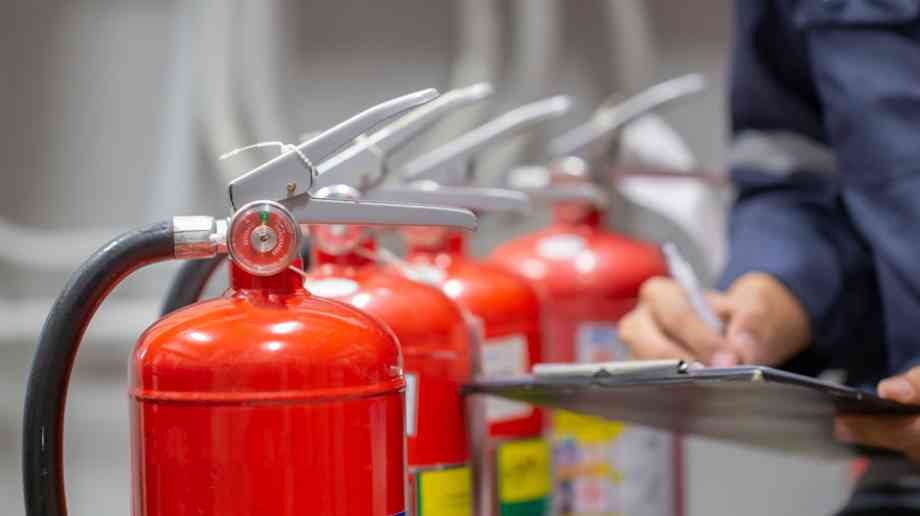Safeguarding Commercial Fire and Electrical Safety Across South England.

Managing risk and saving lives
Zoe Giles, fire risk consultant at the Fire Protection Association discusses the fundamentals of protecting buildings through fire risk assessments and her own journey as a fire risk consultant.
Ensuring the life safety of a building’s occupants (whether domestic or non-domestic) is the basic principle of a credible fire risk assessment (FRA).
Thus, for assessors of fire risk, the level of trust imparted to them by building owners and responsible persons cannot be overstated.
Despite this, we have seen how the evolving legal requirements of FRAs have exposed variations in working practices across the industry. For instance, one responsible person might simply hire an assessor to complete a tick box exercise, while another might be seeking guidance on how to elevate the safety of their premises beyond statutory standards.
Those taking up the profession are likely to be exposed to a multitude of scenarios and clients that challenge their abilities. Ultimately, a career in fire risk consulting requires a clear understanding of the building regulations and an aptitude to adapt according to the category of building, its purpose and use for occupants, and any other relevant information that could be used to determine the level of fire risk present.
Zoe Giles, a fire risk consultant for the FPA, has been working in the industry for over five years. She is registered on the Tiered Fire Risk Assessor Register at Tier 3, otherwise identified as the National Accredited Fire Risk Assessors Register (NAFRAR).
She discusses the fundamentals of FRAs, her own career path as a fire risk assessor, and the challenges assessors can face when it comes to surveying commercial buildings.
How do fire risk assessments vary depending on the type of building being assessed? For example, commercial-use buildings such as hospitals, hotels, and offices.
Fire risk assessments will vary depending on the risk of life to the building users. This is demonstrated in fire safety guidance documents, such as BS 9999, which break down the risk profiles of buildings based on occupants being familiar or unfamiliar with the building, whether they are awake or alert, or whether they are receiving medical care.
When considering life safety, hospitals are classified as higher-risk premises based on the fact that patients may be of very high dependency, asleep, or unfamiliar with the premises, increasing the level of assistance required during an evacuation and the level of staff training required to do this efficiently. This, accompanied by the fire risk of the premisesgiven the nature of the building and the likelihood of dangerous substances such as medical gases, will require a competent risk assessor to complete an informative, suitable, and sufficient fire risk assessment and understand the requirements as set out in the relevant fire safety guidance. For instance, HTM 05-02 (a Health Technical Memorandum that provides information on fire safety in the design of new healthcare buildings and extensions) tends to implement higher standards of fire safety, and therefore, there are many additional factors to consider. The management plan for the premises is critical for the evacuation strategy to be effective and for the risk to life to be managed as best as is reasonably practicable.
On the opposing end of the scale, smaller risk buildings will be determined by those that are occupied by persons who are awake and familiar with their surroundings, such as offices. Thus, life safety risks can vary greatly – the more complex the building, the more fire hazards, risks, and control measures will need to be considered.
What types of things do contractors or manufacturers tend to miss when it comes to fire safety in commercial buildings?
The holistic view of fire safety in commercial buildings is often missed when construction or other types of refurbishment works are being completed. I’ve personally attended premises undergoing invasive refurbishments and witnessed some concerning practices being implemented during the construction phase. These include uncontrolled hot works near significant volumes of combustible fire load, poor standards of housekeeping obstructing the functioning of fire protection systems which are critical for maintaining tenable conditions,
and poor management processes forgetting to reinstate systems, such as isolated automatic fire detectors. The most common – and I’m sure many other risk assessors can agree – is the wedging open of fire doorsets protecting escape routes!
What are the most common reasons a fire risk assessment might raise issues of concern?
There are many common concerns a fire risk assessment may address, some of which I have already referenced. The most important ones often revolve around the actual management of the building. You may have a building that has been constructed according to modern-day standards and that is fully compliant with the Building Regulations. However, bad management practices can have a detrimental effect on the life safety risk of the building as well as business continuity. For example, poor standards of housekeeping in escape routes may prevent them from being accessible in an emergency or heighten the risk of a fire originating if items are stored in close proximity to ignition sources. Poor management of fire doors such as wedging them open will render them ineffective at restricting fire growth. Similarly, not reviewing invasive work to the building structure such as where new cables are installed may also have a detrimental effect on the rapid spread of smoke and fire throughout the building. E
F I would also like to highlight that, more recently, we have seen an emergence in the use of eco-friendly and cost-effective means of transport such as e-bikes or scooters, which has resulted in an increased number of lithium-ion battery fires. Many of these could have been avoided if the charging of such batteries was well managed. Many of the issues I’ve mentioned can easily be combatted by regular fire safety training for staff. This should be more than a tick box exercise for the company, particularly in those buildings where there is a higher risk to life and, admittedly, there is a lot more to lose based on the reliance on staff to instigate a complex evacuation strategy, such as progressive horizontal evacuations.
How are special considerations or evacuation strategies for workers with disabilities or mobility issues currently being met in commercial buildings?
Over the years, the introduction of legislation and subsequent guidance documents has changed the picture, with increased consideration given to disabled evacuation as part of the original building design. These buildings are generally designed with an idea of the end service user in mind, and they will be designed based on the intended evacuation strategy for the premises. For example, a progressive horizontal evacuation will likely be adopted for buildings accommodating large numbers of disabled or mobility-impaired occupants (such as care homes or hospitals), as there will not be a high enough staff-to-occupant ratio to assist an evacuation simultaneously, plus some occupants may be particularly vulnerable and should only leave the building as a last resort (such as those in an operating theatre).
In order for this to be utilised effectively, there must be a high standard of internal compartmentation, fire detection and alarm systems, staff training, and more. The responsible person will have to give special consideration to any staff members employed to work on the premises with disabilities; cooperation and coordination are required to ensure the individual can be safely evacuated from the premises without reliance on the fire and rescue service. This can be achieved with the provision of evacuation aids such as evacuation chairs, safe refuge waiting areas, management through buddy systems, and more.
Can you describe a typical working interaction between a fire risk assessor and a building owner/manager?
The fire risk assessor will likely be appointed by the building owner/manager as the ‘competent’ person to assist them with fulfilling the legislative requirements of the Regulatory Reform (Fire Safety) Order 2005. It is the fire risk assessor’s duty to ensure the responsible person has a full understanding of the duty imposed on them under the legislation and will provide advice on how to maintain a good standard of fire safety within the premises. There may be actions needed as a result of the fire risk assessment, which will require phased planning based on the financial demand. Communication is key and suitable interim measures may need to be discussed to help maintain a reasonable level of fire safety until the project can be completed.
How have the latest amendments to the Fire Safety (England) Regulations 2022 impacted the role of fire risk assessors specialising in commercial buildings (if at all)?
The amendments apply to high-rise residential buildings and do not directly address commercial buildings. However, it should certainly be a discussion point, and consideration should be given to the items addressed in the amendment, especially in terms of communication with the fire and rescue service to assist them when planning and responding to an incident, as there are still varying degrees of risk to life safety in commercial buildings where search and rescue missions may be required.
Issues with competency have been at the forefront of industry discussions in recent years.
How can assessors prevent fire risk assessments from simply becoming a tick box exercise?
It is vital that fire risk assessors avoid complacency and continue to strive to expand their knowledge and experience by exercising and demonstrating competency in their work. Over time, the ideology of a ‘suitable
and sufficient’ fire risk assessment has evolved, but unfortunately, economic factors have also financially impacted the industry. In some circumstances, this has led to a reduction in the time spent on site or the time allocated for report writing. It is important we uphold high standards and provide good quality reports, particularly for more complex premises.
What are the benefits of higher-value fire risk assessments?
Arguably, the greatest benefit of a higher-value fire risk assessment is the fact that it demonstrates the assessor’s due diligence and competency. This will benefit the client as any potential scenarios leading to the increased risk of fire have also been considered, not just what was observed on that day. It will also help maintain confidence and trust between the risk assessor and the client.
As someone registered on the Tiered Fire Risk Assessor Register at Tier 3, this marks you out as being one of just 3 per cent of the estimated national cohort of fire risk assessors, independently accredited to undertake fire risk assessments in complex/high risk premises.
What traits do you think helped you achieve this level and are ones that a fire risk assessor should have?
Accountability – fire risk assessment is what it says on the tin – a risk assessment. Whilst fire safety documents exist and were created to help assist risk assessors, there will be buildings that, unfortunately, are hard to apply and will deviate from traditional assessment. The risk to life should be considered first and foremost, and when asking clients to invest in changes or modifications, you have to weigh up whether they are cost-effective and will provide clear benefits to life safety and property protection. It is important that whatever the decision, you take ownership of your opinions and recommendations and understand the possible repercussions.
It is also important to emphasise that it is impossible to know everything in this industry, so you should equally be able to recognise your own limitations.
Approachability – this is particularly important to build up a good rapport and level of trust with the client. As I mentioned earlier, many fire risk assessments identify issues regarding the management of the building, but having a level of trust may enable you to delve deeper and make the client feel comfortable in being transparent about any concerns they have experienced that you would otherwise not be aware of.
Ambition – it is impossible to know everything in this industry, and therefore, you should have the ambition to learn on the job through research and networking.
What do you enjoy about the role, and what challenges does it bring?
I came upon fire risk consulting by accident after shadowing colleagues at my previous company. I saw how passionate they were and began to take greater interest in reading their reports and learning more about the standards. I have faced imposter syndrome in my career, but I’ve found that the best way to overcome that is being able to back up my professional recommendations about why a client needs to implement changes through understanding the guidance documents and knowing how to advise them clearly.
I love talking to our clients confidently, and I like when we can agree on a cost-effective approach by offering them another, safer alternative. I also enjoy building a relationship with clients so they feel comfortable coming to me for advice about fire safety and value my opinion, experience, and knowledge. I like the idea that we’re trying to make buildings safer and reducing the risk to life, and really enjoy my job.
What advice would you give to other young professionals looking to join this field?
I would say believe in yourself. Do your research and shadow other assessors as much as possible. Then, build up your confidence by going to different sites. Remember to take the time to read the standards and to learn as much as you can. It’s literally impossible to know everything, so accept your limitations. Also, if you find yourself being challenged by a client, don’t let that deter you – your professional opinion matters and you should trust your recommendations.
Finally, never give up. The FPA has been nothing but supportive of my career path, helping me with my training and much more. It can be a risk to employ someone without fire safety experience, but I’ve noticed that many more companies are open to helping people start from the bottom and work their way up.
Life safety cannot always be guaranteed in the event of a fire, but managing risk based on a building’s complexity and use can ensure that the best safety practices are implemented. Fire risk assessors are a crucial part of this process, and it is through their commitment to raising the standards of competent behaviour and being accountable in their work that better systems can be applied and more lives and buildings protected.
Find out more about FPA's fire risk assessment service here.
Company Focus
Event Diary
An essential date in the calendar for those responsible for homeland and global security; International Security Expo returns to Olympia in London on 30 September & 1 October 2025.
Every sport, from grassroots football to world-class tournaments, depends on one constant: high-quality playing surfaces and well-maintained green spaces.
Tickets: Free registration available at www.retailscl.com
The Retail Supply Chain & Logistics Expo is the UK’s leading event for retail supply chain and logistics professionals, showcasing the latest innovations in fulfilment, 3PL, AI-driven automation, and warehouse technology.
Supplier Profiles
Bauder Accepts Keys to its New UK Distribution Centre at Gateway 14
Bauder marked a major milestone in its UK expansion with the official handover of a brand
Words of World: Bridging language barriers with excellence
At Words of World, we specialise in professional translation and interpreting, d
Latest Features
The British Institute of Cleaning Science (BICSc) and the Cleaning & Support Services Association (CSSA) have successfully completed a groundbreaking project aimed at exploring the future of cleaning. This collaboration marks a significant milestone in the cleaning industry, reflecting a shared commitment to embracing innovation with confidence.
The Crown Commercial Service’s (CCS) new framework on Language Services (RM6302), dealing with translation, transcription and interpreting, is live, running from 7th May 2025 to 6th May 2028.










